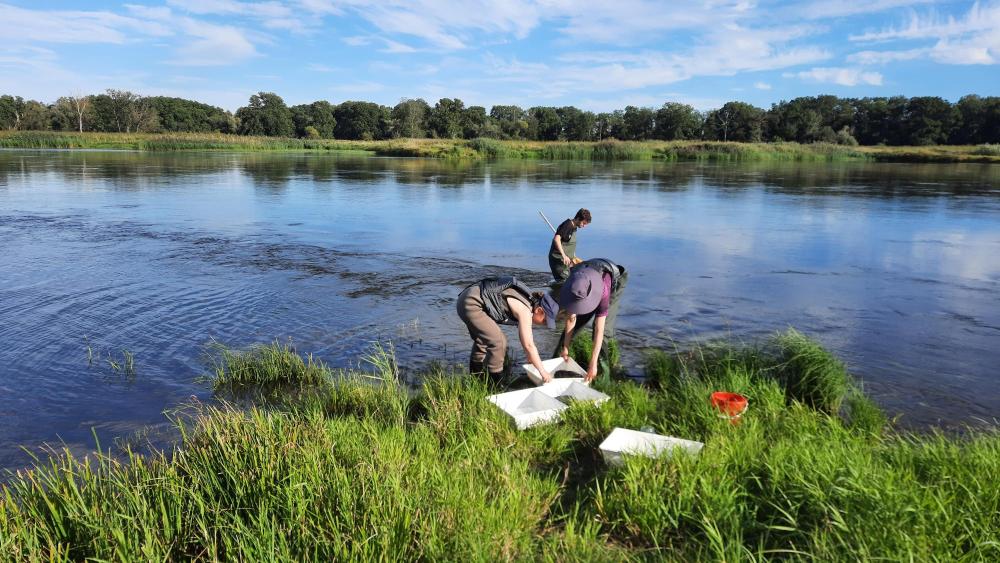
© Rafael Rössl
The multidisciplinary project monitors and analyses algal and pollutant loads, documents the status and recovery of populations of different groups of organisms, conducts precautionary studies on possible future poisoning events and investigates the ecological role of floodplains in different development scenarios. The overall goal of ODER~SO is to create a broad knowledge base for the integrative management of coupled river-floodplain ecosystems, enabling more precise analyses and forecasts of water body status that can serve as a basis for preventive measures against the harmful effects of algal blooms.
Background
During the environmental disaster in the Oder in the first three weeks of August 2022, an estimated 1,000 tons of fish died along a stretch of more than 300 km of the Oder river. The populations of mussels, aquatic snails and presumably other groups of aquatic organisms were also significantly affected. This also affected the section of the river that forms the border between Germany and Poland.
The cause of the catastrophe was recognised as the man-made high salinity of the Oder, which enabled the mass development of the toxic brackish water algae Prymnesium parvum, whose toxin Prymnesin caused the death of aquatic animals. It has not yet been possible to quantitatively estimate the extent of all the damage to the Oder ecosystem. The factors that enabled some of the affected fauna to survive are also still largely unknown.
The German Federal Agency for Nature Conservation (BfN) has therefore commissioned the Leibniz Institute of Freshwater Ecology and Inland Fisheries (IGB) with a special investigation programme with funding from the German Federal Ministry for the Environment, Climate Action, Nature Conservation and Nuclear Safety (BMUKN). The aim of this programme is to comprehensively document the ecological damage, closely monitor the chemical and ecological status of the marginal waters and further clarify the boundary conditions and mechanisms of action of the formation of algal toxins, thereby contributing to the development of an early warning system. The project also aims to document the regeneration of the river ecosystem in order to derive preventive and remedial measures that can increase the resilience and ecosystem services of the entire river-floodplain ecosystem. The work thus also aims to reduce the risks of a recurrence of such an environmental disaster through precautionary research and to identify recommendations for action for more sustainable management of the Oder and its floodplains.
Project objectives and methodology
The project is investigating the course of the environmental disaster, the current state and future aspects with a multidisciplinary approach: scientists from the fields of hydrology, water chemistry, remote sensing, zoology, botany, microbiology, toxicology, environmental DNA, floodplain ecology, ecosystem services and environmental economics are involved. The best available methods are used, such as recording the entire species population of aquatic organisms in the Oder by analysing the environmental DNA contained in the Oder water, recording algae mass developments using satellite images or quantifying the ecosystem services of the Oder floodplains. The scientific experts work in close cooperation with the responsible federal and state authorities.
In line with the multi-layered functional background of the environmental disaster, the project pursues the following objectives:
- Monitoring and analysis of algae and pollutant loads
- Documentation of the remaining populations of important aquatic organism groups
- Documentation of the regeneration of populations of important aquatic organism groups
- Toxin precautionary studies in relation to possible further prymnesin poisoning and development of an early warning system
- Illustration of the resilience and refugial function as well as ecosystem services of floodplains in three development scenarios.
The project objectives are being implemented by 13 sub-projects (SPs), which carry out a wide range of field and laboratory studies and are closely interlinked:
- Coordination of sampling, data management and communication
- Data portal for use with spatio-temporal data structures
- Monitoring and risk assessment of water quality and phytoplankton
- Data synthesis of monitoring, early warning system, and satellite data
- Genomic monitoring of Prymnesium parvum
- Development studies on Prymnesium, e.g. to determine the conditions of mass development of prymnesium and its toxins
- Toxicity of Prymnesium: effects on early life stages of fish including sturgeon, mussels and zooplankton
- Measurement of zooplankton and mussel filtration to visualise the biological control mechanisms of algae mass development
- eDNA-based multitrophic monitoring of aquatic organisms with a focus on Prymnesin-vulnerable organisms
- Quantification of the recovery of macrozoobenthos colonisation in the middle of the river (10a) and in the wadeable bank zones (groyne fields) and adjacent floodplain waters (10b)
- Determination of the decline and expected recovery of fish populations and investigation of the refugial function of floodplain waters
- Biocoenotic floodplain assessment (12a) // Insect emergence in floodplain waters (12b)
- Development scenarios for the Oder and its floodplains
The project results serve to deepen the hitherto incomplete knowledge of the functional relationships that were effective during the environmental disaster. They also make it possible to comprehensively describe the very high ecological and economic damage for the first time and to derive recommendations for action to reduce the risk of comparable damage or further deterioration. It is expected that the project results will provide the responsible regional authorities, agencies, committees and companies – including the Lower Oder Valley National Park – with important impetus for environmental monitoring and the water and nature conservation management of the Oder and its floodplains. In this way, the project also significantly supports the efforts of the federal and state authorities to achieve the legal objectives of water management and nature conservation faster and better.
In the scientific field, the project will enable a considerable improvement in knowledge about the Oder, which has not been the subject of such intensive research for several decades. The project will also contribute to improving the level of knowledge of the interested public and regional stakeholders about the ecosystem of the Oder and its floodplains, enabling them to act more effectively in the event of such disasters and to support an environmentally friendly, sustainable development in the region.





